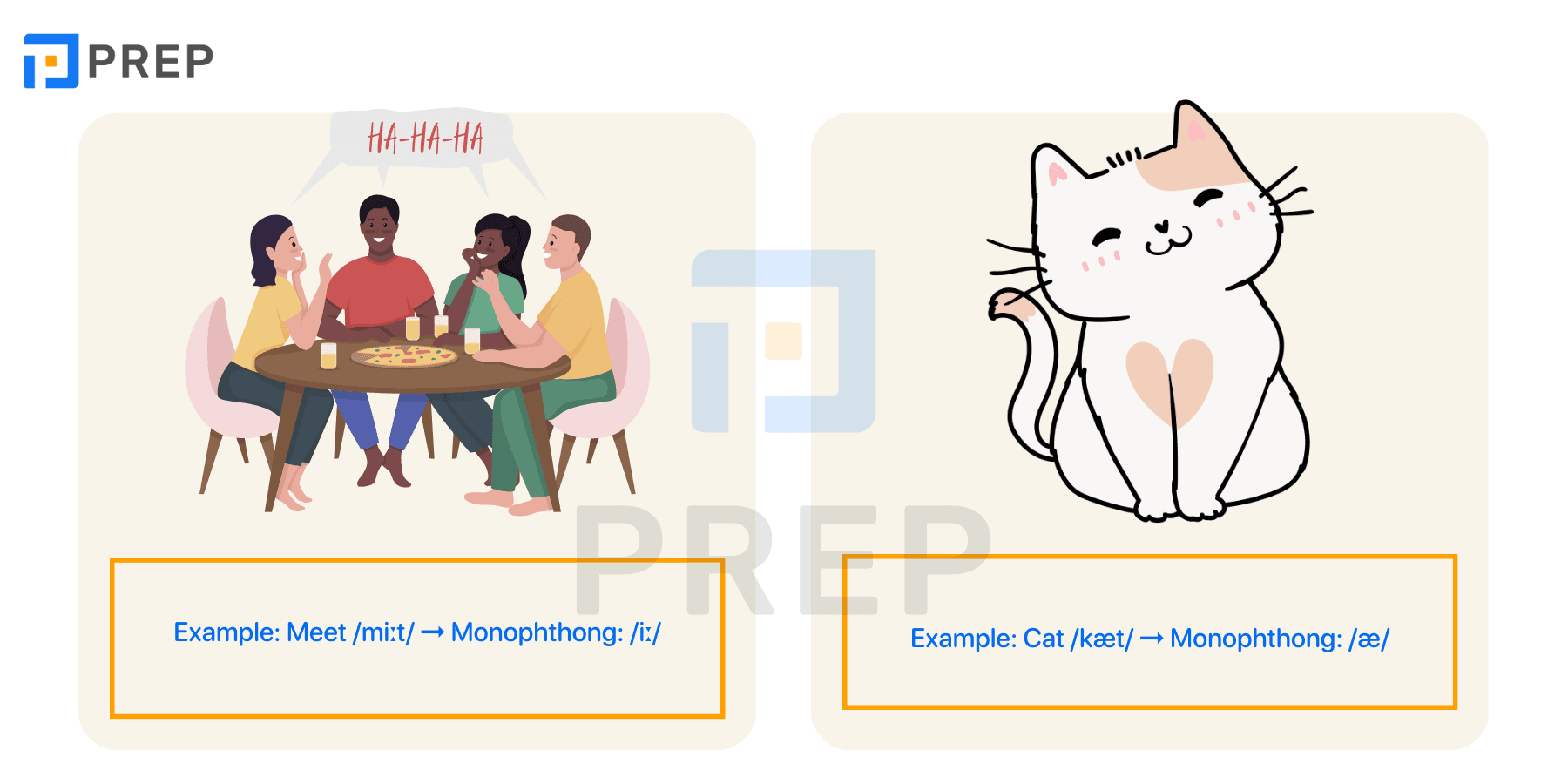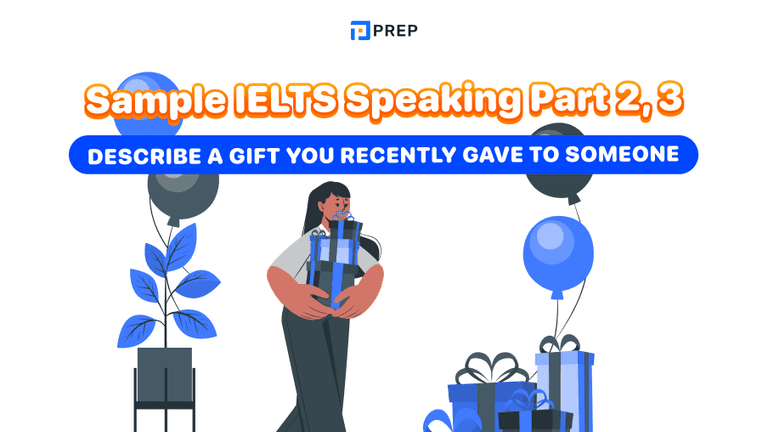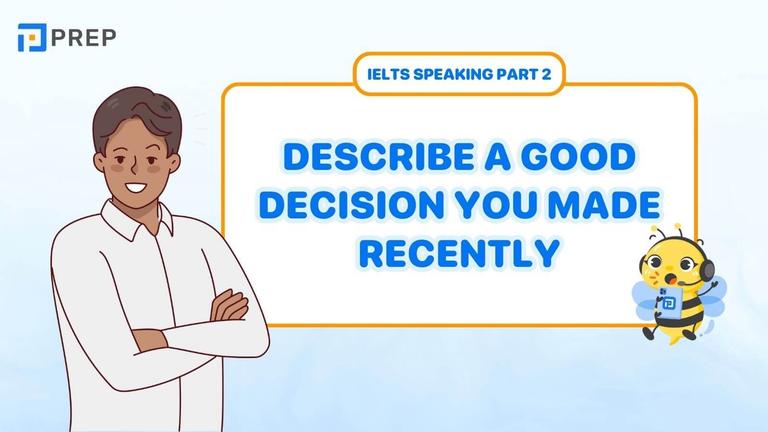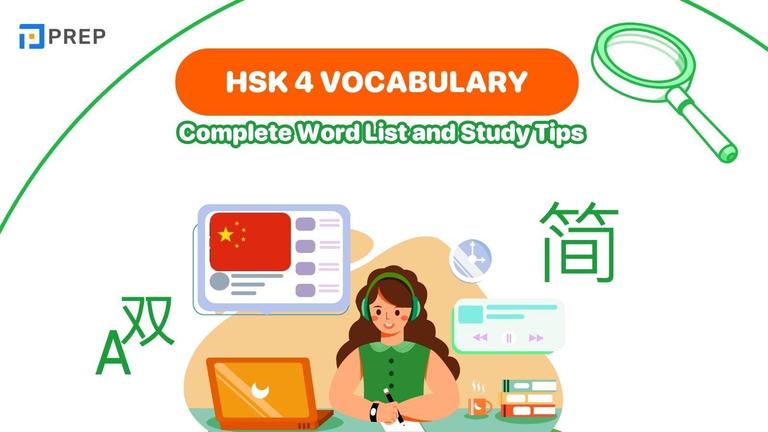English Monophthongs: Meaning, Types, and How to Learn
English monophthongs are pure vowel sounds essential to clear pronunciation. This guide explains what they are, how they appear in the IPA chart, and how to pronounce them accurately. You'll also learn key differences from diphthongs and find practical resources to help you practice.

I. What Are English Monophthongs?
English monophthongs are single, pure vowel sounds in which the tongue and mouth remain in one fixed position throughout the articulation of the sound. Unlike diphthongs, they do not glide from one vowel quality to another.
For example, the vowel sound /ɪ/ in the word "bit" is a monophthong. The shape of the mouth stays the same from beginning to end.
Monophthongs are the building blocks of English pronunciation. Depending on the accent, English contains around 12 monophthongs, which form a key part of its vowel inventory. These sounds differ in terms of:
- Tongue position (front, central, back)
- Height of the tongue (close, mid, open)
- Lip shape (rounded or unrounded)
Mastering monophthongs helps learners correctly pronounce thousands of common English words and improves both listening comprehension and spoken accuracy.

For language learners, understanding monophthongs improves the ability to distinguish between similar-sounding words (e.g. ship /ʃɪp/ vs. sheep /ʃiːp/), enhances clarity in communication, and supports higher scores in pronunciation-related criteria in standardized exams like IELTS Speaking or TOEFL iBT Speaking.
In many cases, incorrect use of monophthong sounds results in misunderstandings, especially between minimal pairs. Developing awareness of mouth position and vowel length is essential for achieving natural and intelligible speech in English.
To fully understand how vowel sounds fit in the sound system, you should also review vowels and consonants in English.
1. List of English Monophthongs with IPA Symbols
English monophthongs are typically represented using International Phonetic Alphabet (IPA) symbols. In the Received Pronunciation (RP) model of British English, there are 12 standard monophthong vowel sounds, each with a unique articulatory position and sound quality.
Below is the full list of English monophthongs with their IPA symbols and example words:
|
IPA Symbol |
Example Word |
Keyword Sound |
Vowel Type |
|
/iː/ |
see |
long ee |
high front, tense |
|
/ɪ/ |
bit |
short i |
high front, lax |
|
/e/ |
bed |
short e |
mid front, lax |
|
/æ/ |
cat |
short a |
low front, lax |
|
/ʌ/ |
cup |
short u (strut) |
mid-central, lax |
|
/ɑː/ |
car |
long ah (palm) |
low back, tense |
|
/ɒ/ |
cot (BrE) |
short o |
low back, lax |
|
/ɔː/ |
call |
long aw |
mid back, tense |
|
/ʊ/ |
book |
short oo |
high back, lax |
|
/uː/ |
food |
long oo |
high back, tense |
|
/ɜː/ |
bird (BrE) |
er (non-rhotic) |
mid-central, tense |
|
/ə/ |
sofa (unstressed) |
uh (schwa) |
mid-central, neutral |
Notes:
- The schwa /ə/ is the most common vowel in English, usually found in unstressed syllables.
- Some of these sounds vary slightly in quality between British (RP) and American English. For example:
- /ɒ/ in cot (BrE) often becomes /ɑː/ in AmE.
- /ɜː/ in bird is typically pronounced as /ɝː/ (with r-coloring) in AmE.
These monophthongs are plotted on the IPA vowel chart according to tongue height and tongue position, which learners can visualize more easily in the next section.
2. English Monophthongs vs. Diphthongs
Understanding the difference between monophthongs and diphthongs is essential for accurate English pronunciation. Though both are vowel sounds, they differ in how the tongue moves and how the vowel is produced within a syllable.
|
Feature |
Monophthongs |
Diphthongs |
|
Number of sounds |
Single vowel sound |
A glide between two vowel sounds |
|
Tongue movement |
No movement (fixed mouth/tongue position) |
Tongue shifts from one position to another |
|
Sound stability |
Stable throughout the syllable |
Begins with one vowel and transitions to another |
|
Examples (IPA) |
/ɪ/, /æ/, /uː/, /ɑː/ |
/aɪ/ (as in bike), /eɪ/ (as in day) |
|
Example words |
bit, cat, food, car |
my, face, go, voice |
A monophthong like /æ/ in cat is produced with a single, unchanged mouth position. Meanwhile, a diphthong like /aɪ/ in time starts with the mouth open wider and then glides to a tighter, higher position.
Learners often confuse monophthongs and diphthongs because:
- In some accents (especially non-native English accents), monophthongs are unintentionally turned into diphthongs and vice versa.
- Minimal pairs due to vowel shifts (e.g. ship vs. shape) can be difficult to differentiate in listening tests like IELTS.
Distinguishing between monophthongs and diphthongs helps:
- Avoid pronunciation errors that affect listener comprehension.
- Improve listening skills, especially for minimal-pair identification.
- Increase pronunciation accuracy in high-stakes speaking evaluations like IELTS or TOEFL.
Learners should practice both sets of vowel sounds in isolation and in context by:
- Listening to native speakers
- Recording and comparing pronunciation
- Focusing on tongue and jaw movement during sound production
III. How to Pronounce English Monophthongs Correctly
Correct pronunciation of English monophthongs requires more than just memorizing symbols. Because these are pure vowel sounds, producing them accurately involves controlled mouth positioning, consistent tongue placement, and steady airflow. This section explains how to form each sound and avoid common pronunciation mistakes.
Mouth Positioning and Articulation Tips
English monophthongs are defined by where and how the vowel is formed in the mouth. Each sound differs based on three main factors:
- Tongue height: high, mid, or low
- Tongue position: front, central, or back
- Lip shape: rounded or unrounded
General Guidelines:
- Front vowels (e.g. /iː/, /e/, /æ/) → tongue moves forward; lips unrounded
- Central vowels (e.g. /ʌ/, /ɜː/, /ə/) → tongue rests in the middle of the mouth
- Back vowels (e.g. /uː/, /ɔː/, /ɑː/) → tongue moves toward the throat; lips may be rounded
Example techniques:
- To pronounce /ɪ/: Keep your lips relaxed; front of tongue raised slightly (e.g. bit)
- For /uː/: Round your lips; raise the back of your tongue (e.g. blue)
- For /æ/: Open your mouth wider; tongue stays low and toward the front (e.g. cat)
Aim for sound stability: Monophthongs should be held steady; avoid gliding or mouth movement during the vowel.
Common Pronunciation Mistakes to Avoid
Learners often make errors when producing monophthongs due to interference from their native languages or misunderstanding the sound’s mechanics.
Common issues include:
- Inserting movement, turning a monophthong into a diphthong
(e.g. pronouncing /ɪ/ as /i/ + /ə/) - Over-lengthening or shortening vowel duration unnaturally
- Backing or fronting vowels incorrectly due to L1 influence
(e.g. pronouncing /æ/ as /ɛ/ or /ɑː/ as /ʌ/)
Specific attention for learners:
- Vietnamese speakers may have difficulty distinguishing /ɪ/ vs. /iː/ or /æ/ vs. /ɛ/
- Mandarin speakers may shift monophthongs toward diphthongal realizations
- Arabic speakers may delete central vowels like /ə/ or misplace /ʌ/
IV. British vs. American Monophthong Pronunciation
Although British English (BrE) and American English (AmE) share the same core set of monophthong sounds, there are notable differences in how these vowels are pronounced across the two accents. Understanding these differences is important for learners who want to sound consistent, especially in speaking exams or when choosing which accent to follow.
Below are some common distinctions in pronunciation between the two accents:
|
IPA Symbol |
Example Word |
British English (BrE) |
American English (AmE) |
|
/æ/ |
cat |
[æ] – quite open |
[æ] – often tenser and closer to /eə/ in some regions |
|
/ɑː/ |
car |
[ɑː] – long open back |
[ɑː] or [ɑ] – but only in words like “spa”; "car" often merges with /ɹ/ |
|
/ɒ/ |
hot |
[ɒ] – rounded back vowel |
Often replaced with /ɑ/ = [hɑt] |
|
/ɔː/ |
thought |
[ɔː] – clearly rounded |
May be merged with /ɑː/ in some dialects (cot–caught merger) |
|
/ɜː/ |
bird |
[ɜː] – non-rhotic (BrE) |
[ɝː] – with r-coloring (AmE) |
|
/ə/ |
about |
[ə] – reduced vowel |
[ə] – same function, but may differ slightly in length and clarity |
In exams like IELTS or TOEFL, both British and American accents are fully accepted—as long as they are used consistently. Switching accent mid-sentence (such as using BrE /ɒ/ in one word and AmE /ɑ/ in another) can create unnatural speech and may impact pronunciation grading.
- IELTS tip: Since IELTS is written and assessed by many British examiners, sticking to BrE vowel sounds may slightly align with examiner expectations—but this is not required. Clear and consistent pronunciation is more important than accent choice.
- TOEFL tip: TOEFL tends to reflect North American English in its listening comprehension and test materials, so using AmE often feels more intuitive for TOEFL learners.
V. Practice Materials: Monophthong Exercises and Resources
Learning the theory of monophthongs is important—but consistent practice is what leads to improvement. In this section, you’ll find curated exercises and recommended tools to help you master English monophthongs through repetition, correction, and real-world application.
Monophthong Practice Exercises
Choose the answer that has a different pronunciation than the other words.
|
1. |
A - stood |
B - choose |
C - look |
D - took |
|
2. |
A - heavy |
B - head |
C - weather |
D - easy |
|
3. |
A - eliminate |
B - expedition |
C - separate |
D - preparation |
|
4. |
A - canoeing |
B - career |
C - canal |
D - caring |
|
5. |
A - command |
B - compose |
C - complain |
D - comment |
|
6. |
A - toll |
B - cholera |
C - moth |
D - proper |
|
7. |
A - butter |
B - put |
C - sugar |
D - push |
|
8. |
A - flood |
B - good |
C - foot |
D - look |
|
9. |
A - art |
B - paper |
C - late |
D - lazy |
|
10. |
A - pretty |
B - get |
C - send |
D - well |
Answers
|
1 - B |
6 - A |
|
2 - D |
7 - A |
|
3 - A |
8 - A |
|
4 - D |
9 - A |
|
5 - D |
10 - A |
Recommended Tools and Apps for Monophthong Practice
Modern learning tools make monophthong pronunciation more accessible, visual, and interactive. Here are some of the most effective platforms:
|
App / Resource |
Features |
Best For |
|
Elsa Speak |
Uses AI to detect vowel errors and improve accent with real-time feedback |
Personalized monophthong practice |
|
Sounds: The Pronunciation App |
Offers full IPA charts, listening practice, and interactive tests |
Visual learners exploring IPA |
|
YouGlish |
Provides video clips of real people using words in natural context |
Contextual listening and modeling |
|
Pronunciation Studio (website) |
Video breakdowns of individual monophthong vowel sounds |
Learners who want structured lessons |
Recommendation: Start by identifying your weakest sounds, then use apps like Elsa or YouGlish to focus on those vowels in isolation and in full sentences.
In addition, regular practice IELTS Speaking with feedback ensures monophthongs are used fluently in real test settings.
VI. Final Tips for Mastering English Monophthongs
Mastering English monophthongs requires more than just understanding theory—it involves consistent, focused practice and awareness of your own pronunciation habits. Below are some key strategies to help you apply the knowledge effectively.
Build Listening Awareness
Understanding how monophthongs sound in real speech is the first step toward producing them clearly.
- Listen to native speakers through podcasts, audiobooks, or interviews.
- Focus on minimal pairs (e.g., ship vs. sheep, cot vs. cut).
- Watch content with subtitles and repeat aloud for reinforcement.
- Use tools like YouGlish to hear words pronounced in real contexts.
Practice with Shadowing Techniques
One proven method is the shadowing technique, which helps learners internalize vowel sounds in natural rhythm. Shadowing means listening to native speech and repeating it simultaneously.
- Choose short clips with clear pronunciation (news, TED Talks, education channels).
- Focus on vowel stability, mouth shape, and word stress.
- Record yourself and compare with the original to catch subtle differences.
- Repeat at normal speed to simulate natural rhythm and intonation.
Integrate Monophthongs into Stress and Rhythm Practice
Monophthongs don't appear in isolation during conversation. Practice them in real speech patterns for better retention and fluency.
- Learn how each vowel behaves in strong vs. weak syllables.
- Practice sentence-level intonation with emphasis on vowel clarity.
Example: “I need to fix this ship before it sinks.” (focus: /ɪ/) - Combine vowel practice with connected speech and word linking.
Be Consistent with Your Chosen Accent
Whether you follow British English (BrE) or American English (AmE), it’s important to apply monophthong pronunciation consistently.
- Avoid mixing vowel qualities between the accents in the same conversation.
- Choose one model and stick to it in both practice and exams.
The above has introduced the definitions, correct pronunciations, and practice exercises for English monophthongs. Let’s follow PREP regularly to stay updated on lots of useful knowledge!

Hi I'm Chloe, and I am currently serving as an Product Content Administrator at Prep Education. With over five years of experience in independent online IELTS study and exam preparation, I am confident in my ability to support learners in achieving their highest possible scores.
Comment
Premium content
View allPersonalized roadmap
Most read












